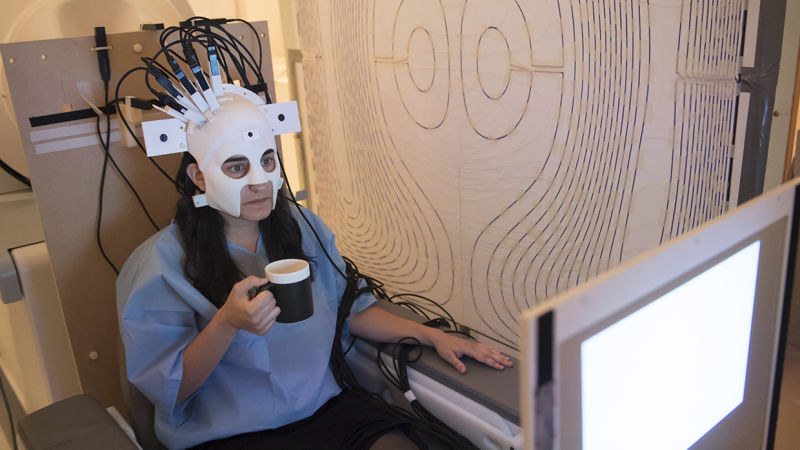Wearable brain scanners to enable broader, easier, cheaper access to neuroimaging

Credit: University of Nottingham
___
This Brain Scanner Is Way Smaller Than fMRI but Somehow 1,000% Creepier (Gizmodo):
“It may look like something befitting Halloween’s Michael Myers, but the device pictured above is actually a breakthrough in neuroscience—a portable, wearable brain scanner that can monitor neural activity while a person is moving… It uses a technology called magnetoencephalography, or MEG, which measures magnetic signals generated by the brain’s electrical currents at the scalp. With mathematical analysis, those fields can be used to create a 3D map of brain function with millisecond resolution.
…British researchers managed to shrink the technology down to an over-sized helmet with the help of quantum sensors. Each sensor contains a gas of rubidium atoms with properties aligned by a laser beam. Brain activity can cause a tiny magnetic field, and thus induce tiny changes to these atoms, decreasing the intensity of the beam. All this allows for a sensor that doesn’t need to be supercooled the way competing scanners do. In tests of the device, they note that the technology also enables scanning of the brain during more natural activities, like drinking a cup of coffee.”
The Study
Moving magnetoencephalography towards real-world applications with a wearable system (Nature).
- Abstract: Imaging human brain function with techniques such as magnetoencephalography1 typically requires a subject to perform tasks while their head remains still within a restrictive scanner. This artificial environment makes the technique inaccessible to many people, and limits the experimental questions that can be addressed. For example, it has been difficult to apply neuroimaging to investigation of the neural substrates of cognitive development in babies and children, or to study processes in adults that require unconstrained head movement (such as spatial navigation). Here we describe a magnetoencephalography system that can be worn like a helmet, allowing free and natural movement during scanning. This is possible owing to the integration of quantum sensors, which do not rely on superconducting technology, with a system for nulling background magnetic fields. We demonstrate human electrophysiological measurement at millisecond resolution while subjects make natural movements, including head nodding, stretching, drinking and playing a ball game. Our results compare well to those of the current state-of-the-art, even when subjects make large head movements. The system opens up new possibilities for scanning any subject or patient group, with myriad applications such as characterization of the neurodevelopmental connectome, imaging subjects moving naturally in a virtual environment and investigating the pathophysiology of movement disorders.
The Study in Context
- Five reasons the future of brain enhancement is digital, pervasive and (hopefully) bright
- 10 neurotechnologies about to transform brain enhancement and brain health
- Firms Race to Find New Ways to Scan Brain Health
- Study combines neuroimaging with machine learning to predict, with 96% accuracy, whether high-risk 6‑month-old babies will develop autism spectrum disorder (ASD) by age 2


